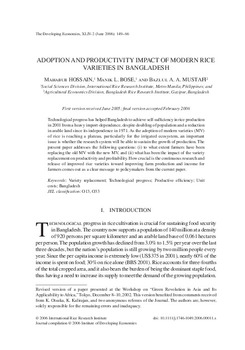Adoption and Productivity Impact of Modern Rice Varieties in Bangladesh
Abstract
The Bangladesh research system has been continuing to release new rice varieties with novel traits. The improved varieties have spread to nearly two thirds of the rice area. The technological progress has helped Bangladesh to achieve self-sufficiency in rice production in 2001 from a heavy import-dependence at Independence in 1971, despite doubling of population and a reduction in arable land since then. As the adoption of modern varieties (MVs) is reaching the plateau particularly for the irrigated ecosystem, an important issue is whether the research system will be able to sustain the growth of production This paper asks the questions a) to what extent farmers have been replacing the old MVs with the new ones, and b) what has been the impact of the variety replacement on productivity and profitability. It is found that during the first two decades of the green revolution the increase in yield came mostly from gradual replacement of the low-yielding traditional varieties (TVs) with the high-yielding modern ones. Farmers have been slow in replacing the old MVs. In the1990s, however, there has been an increase in yield in the season-specific MVs and an increase in profitability due to the spread of agricultural mechanization. A production function analysis shows higher technical efficiency in successive generations of MVs

